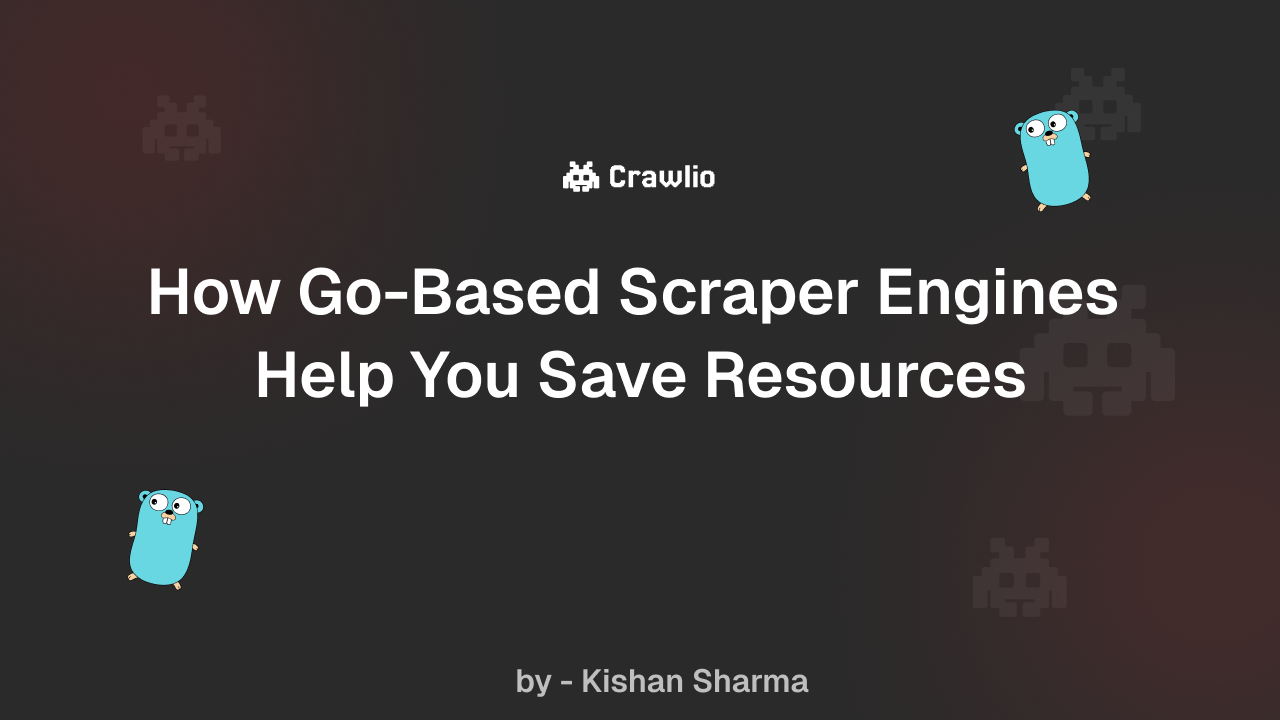How Go-Based Scraper Engines Help You Save Resources — And Where Crawlio Stands

When it comes to scraping websites, developers often focus on getting the job done. But under the hood, the cost of doing that job—in terms of memory and CPU—can vary widely depending on how your scraper is built.
Scraping Isn’t Just About the Browser
A lot of scraping solutions (like Puppeteer or Playwright) lean heavily on browsers to render pages and extract content. But the actual scraping logic—the part that parses the DOM, extracts elements, and processes content—is typically implemented in JavaScript, Python, or Go.
It’s this scraper engine logic—the code you write to say “get this div,” “wait for this selector,” etc.—that determines how much RAM your logic layer consumes. That’s separate from the cost of running a headless browser (like Chromium).
Crawlio's Scraper Engine: 7–15MB RAM
The scraping engine behind Crawlio is written with performance in mind. This is the part that:
- Parses the HTML
- Applies CSS selectors or XPath
- Handles retries, error logic, and timeouts
- Processes response metadata
This part of Crawlio—the scraper logic itself—runs consistently within 7–15MB of RAM per instance. That's without counting any browser overhead, and that’s a strong result for what it delivers.
By keeping the core scraper lightweight, Crawlio minimizes total system resource usage, especially compared to the overhead you typically see with interpreted runtimes like Python or Node.js.
Typical RAM Usage: Python and Node.js Scrapers
Let’s look at what you can expect in practical terms when building your own scrapers:
| Stack | Scraper Logic RAM (approx) | Notes |
|---|---|---|
| Go (compiled) | 7–15MB | Crawlio’s engine, or Colly-like setups |
| Python (e.g., BeautifulSoup) | 30–80MB+ | Python interpreter + libs + data in memory |
| Node.js (e.g., Cheerio) | 50–100MB+ | Node runtime + parsing libs like jsdom or Cheerio |
| Browser overhead (Chromium) | 200–400MB per tab | Applies across all stacks using headless browsers |
So even before you launch a browser, a Python or Node.js-based scraper is often using 3–10x more memory than a Go-based equivalent. Add browser tabs, and the difference becomes even more significant.
Go Libraries for Web Scraping (and When to Use Them)
If you're building your own scraper in Go, here's a breakdown of the current ecosystem:
1. Colly
- Use for: Static websites and fast scraping pipelines
- Pros: Extremely lightweight; great performance
- Cons: No JS rendering support
- RAM usage: ~5–15MB per worker
2. chromedp
- Use for: Pages requiring JS execution
- Pros: Direct Chrome DevTools Protocol (CDP) control from Go
- Cons: Browser must be installed and managed
- RAM usage: Scraper logic: ~10MB; browser: 200–300MB/tab
3. go-rod
- Use for: Advanced browser automation, stealth scraping
- Pros: Higher-level API than chromedp, still CDP-based
- Cons: Same browser memory cost as chromedp
- RAM usage: Similar to chromedp
Crawlio’s Position: A Hosted, Lightweight Alternative
Crawlio takes a hybrid approach. You get:
- A scraper engine that runs lean (~7–15MB) and handles your logic
- Optional browser-based fetching when dynamic content needs to be rendered
- A hosted API, so you don’t have to manage memory, retries, proxies, or infrastructure
This makes it easy to integrate into Go, Python, or Node.js backends without paying the RAM tax associated with browser-based approaches unless necessary.
Conclusion: Choose Based on Context
| Scenario | Recommended Approach |
|---|---|
| Lightweight static scraping | Go + Colly or Crawlio |
| Pages with simple JS needs | Go + chromedp or go-rod |
| Full JS rendering + hosted abstraction | Crawlio |
| Quick scripting / existing Python stack | Python + BeautifulSoup / Playwright (watch RAM) |
If you care about memory efficiency, simplicity, or are running multiple concurrent workers, Go offers a clear advantage at the scraping logic level. Crawlio builds on that same principle, providing a low-footprint engine that performs well without browser bloat—unless you explicitly need it.
Scrape Smarter, Not Harder
Get the web data you need — without the headaches.
Start with zero setup. Use Crawlio’s API to scrape dynamic pages, search results, or full sites in minutes.